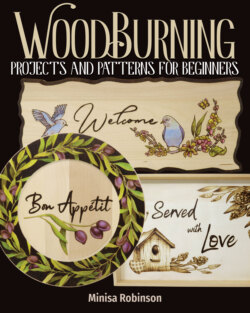Читать книгу Woodburning Projects and Patterns for Beginners - Minisa Robinson - Страница 5
На сайте Литреса книга снята с продажи.
ОглавлениеINTRODUCTION
Pyrography is an ancient art form where a hot tool is used to burn images onto wood, paper, gourds, leather, and other fire-friendly materials. It’s more commonly known as woodburning because wood is often the medium of choice for the art form, and advancements in technology afford artists with various quality tools such as electric woodburning pens. Pyrography is incredibly versatile and can be used in countless ways, from adding simple embellishments onto carved wood, to decorating home décor items, and even creating high-quality realistic works of art.
This book is meant to teach the art of woodburning and ignite your artistic senses. Pyrography can be added to most species of unfinished wood, which opens a world of creative opportunities. The projects in this book also include the option for color, so the possibilities are endless.
A Timeline of Learning
This is a beginner’s book, and before I show you my favorite artworks, I think it’s important to show you my journey as a pyrographic artist. We all start as beginners and must grow from there. I am a self-taught artist, and most of my progress has come from a combination of trial, experiment, practice, and—above all else—attempting projects that were beyond my current skill level. Why? Because it was the catalyst that pushed me to greater learning. As artists, we are never stagnant, and we are always learning with each and every project. The willingness to learn is one of the greatest teachers in life, and I hope you will always be willing to attempt that next challenge. So, before we proceed, here are some of my first attempts at pyrography, which are also some of my most important projects.
This was the project that hooked me on pyrography. It was my first attempt at woodcarving with a Dremel® tool, and I was frustrated that I couldn’t see my carving well. I purchased a simple woodburning tool from my local store and tried to burn over the carving so it would look better. I immediately learned a few things: first of all, woodcarving wasn’t really my thing; secondly, I ruined my first woodburning point by pressing too hard; and lastly, I absolutely loved pyrography!
The project that made me realize my love for pyrography.
When I first started woodburning, I didn’t have any wood to burn on, so I walked into the surrounding forests at my home in Colorado and cut down a small aspen tree with a hatchet. I peeled off the bark, cut it into small sections, and used that small tree for my first few pyrography projects.
I look back at my first project and know that I’ve learned so much since then, but that learning curve is so important to all artists. This was my first steppingstone on my woodburning path.
Be willing to give life to new ideas.
My second woodburning project was on another small section of the aspen tree I cut down. At that time, I was afraid that the woodburning smoke would possibly trigger the smoke alarms of our small cabin, so I made this outside on the deck. It was a frigid autumn afternoon, and the woodburner was the only thing keeping my hands from getting too cold. I had no reference photo or guidelines and sketched out this small elk before dark. After the project was finished, I showed my husband, and his kind words were the spark that encouraged me to try again.
My second woodburning project, burned without any references.
Embrace the practice of practice.
This was my third project and the first time I used a printed-out reference photo with graphite paper. It was a big help to lay out the outlines of the piece, and I used the Dremel® tool to carve out the sun behind the bison. At this point, I realized that my options for pyrography were truly unlimited and I couldn’t wait to try more ideas.
My third project opened my eyes to the unlimited possibilities pyrography can offer.
Imagination and creativity know no bounds.
Most of my first projects were created on round pieces of aspen, but I wanted to try a flat piece, so my husband cut a slab of aspen with his chainsaw for me. This was my first flat woodburning, and I quickly realized the importance of sanding the wood before burning. The surface was very rough and difficult to burn on, and at this point, I was still experimenting with different tips and ways to use them. This woodburning piece was a huge learning experience, and it pushed me to create more realistic woodburnings.
My first flat project taught me the importance of first sanding your wood.
Never stop growing!
